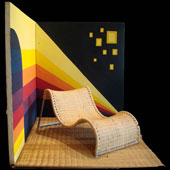Colour and Composition
Exercise-2:
Exploration and Exercises - Hue Composition:
Duration:
1 day, Individual Exercise.
Objective:
Different hues behave in their own way to addition of a different colour. The exercise was designed to sharpen the student’s sensitivity to a very perceptual quality of color: “Brilliance” and in turn make the student receptive to shading.
Mode:
Replicate the composition made in Exercise-1 in one hue out of the following-Poster red, lemon yellow, Prussian blue, light green, orange, violet, yellow ocher, pink (341), peacock blue, poster green, vermillion, flesh tint, burnt sienna, chrome yellow (085).
Materials:
Paint and Brush
Discussion in the Class:
Simultaneous contrast
Observations:
Once the intention was clearly defined to the students they were quick to grasp the concept and apply it to their respective compositions.
There were two typical ways in which the students carried out the exercise:
• Develop shades and tints of the pure hue and then replicate the composition done in Exercise-1.
• The second approach was to first find that specific shade/tint of gray from the gray scale that matched the pure hue in brilliance. And then develop appropriate number of shades or tints required. For instance the student would be making more shades than tints in a pure yellow composition or in the case of purple the number of tints would be more.










